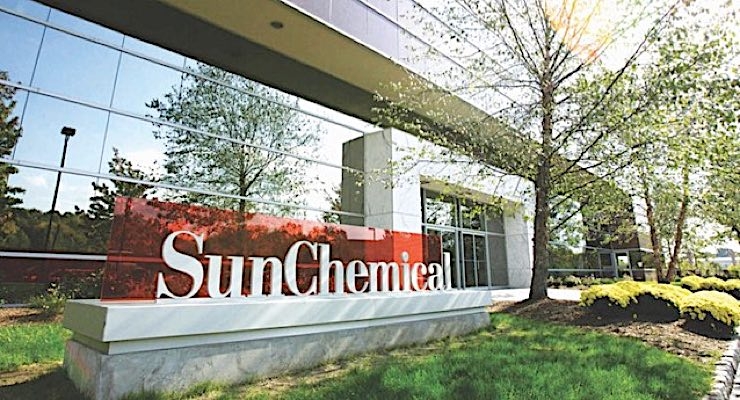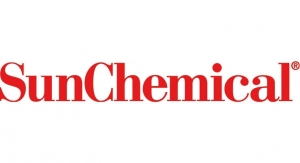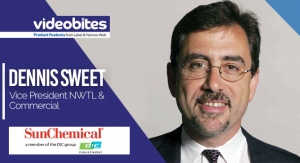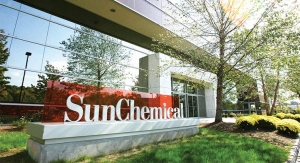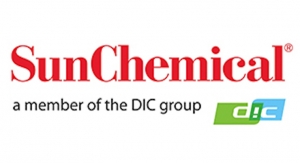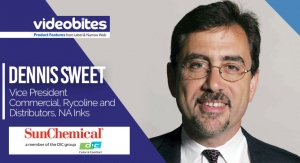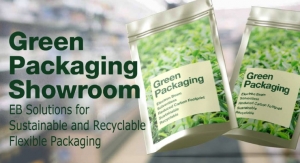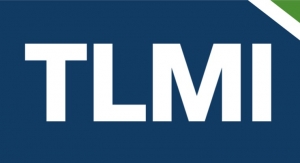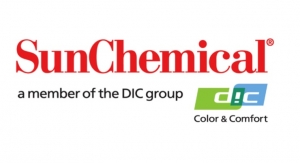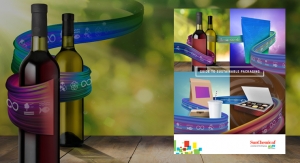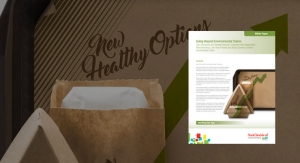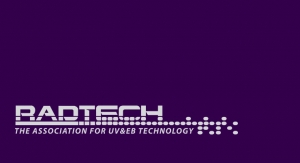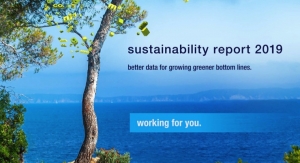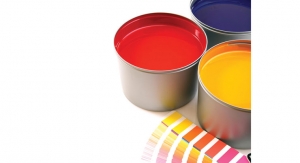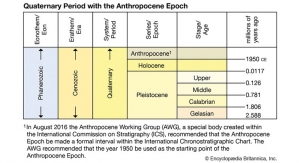Greg Hrinya, Associate Editor02.28.19
With the majority of narrow web printing done flexographically, ink developers continue to engineer new products to meet industry demands. Sun Chemical, a producer of printing inks, coatings and supplies, pigments, polymers, liquid compounds, solid compounds and application materials, offers a wide range of products, such as water-based, solvent-based and UV-cured flexo inks, for multiple applications.
The industry’s newest inks need to run faster and more efficiently, all while being more sustainable and adhering to a rash of government regulations. The inks also need to run on multiple substrates.
“Sun Chemical has seen many new challenges for inks to perform in different conditions,” explains Tony Renzi, vice president, Product Management-Packaging Inks, Sun Chemical. “We have improved our ink systems to adapt to meet the needs of our customers. Inks are being asked to do something new for converters all the time and Sun Chemical has answered, whether the inks need to be formulated with renewable or natural raw materials, meet the strictest regulations, perform at the highest print speeds, and more.”
Sun Chemical’s newest products have been designed for labels, flexible packaging, shrink sleeves, folding cartons, and more. Most recently, the ink supplier has launched SunCure Accuflex UV, SunCure UV Flexo LED, SunCure UV Flexo Shrink, SunVisto AquaGreen, and SunUno Solimax.
SunCure Accuflex UV is a new UV ink system designed for primary and secondary food packaging that is not manufactured with Bisphenol A (BPA)-based materials and meets low migration specifications. Compliant with the strictest global standards in the marketplace, SunCure Accuflex UV flexo inks meet the latest photoinitiator safe packaging guidelines and provide low odor and very low residual extractables characteristics. Meanwhile, SunCure UV Flexo LED inks are designed to meet need of growing LED market and application. These inks can be used with the newest high-speed presses running at 385 and 395 nanometers and can also be used under standard mercury vapor lamps.
Sun Chemical has also developed SunCure UV Flexo Shrink, an ink system designed for the growing shrink sleeve market, especially around nutraceutical (dietary supplements and food additives) and other beverage containers. These inks can provide shrink results up to 70% on appropriate substrates, and under suitable conditions they offer high color strength and color consistency.
SunVisto AquaGreen is an ink system formulated with significantly higher levels of bio-renewable sourced resin content compared to other previous market offerings from Sun Chemical. The new water-based inks deliver the required critical performance attributes needed across a range of paper packaging applications to meet the needs brands have for truly sustainable packaging in quick service supermarkets and restaurants. SunUno Solimax is a multi-purpose ink system that maximizes pressroom efficiency while simplifying the overall print production process. Intended for surface printing and lamination for various end use applications, such as lidding materials, medical laminates and food packaging for confectionery and snack food, these inks provide a single platform that can cover multiple end use applications and produce the shelf stand out and high-quality packaging needed for today’s competitive industry.
“Sun Chemical continues to provide the widest breadth of products available on the market for the wide and narrow web flexographic printing market,” says Renzi. “Our products have performance attributes like heat-resistance, water-resistance, high adhesion or flexibility and much more. Our ink products are complemented by our portfolio of coatings, varnishes, and adhesives.”
Sun Chemical’s inks have also been designed to adhere to a host of regulations. According to Renzi, energy curable inks have faced increased regulatory scrutiny in recent years. “Worries in the marketplace exist that some photoinitiators are unsafe for food packaging,” he says. “In some places, such as California, certain photoinitiators may create other challenges. As the trusted go-to leader for safer food packaging inks and coatings and the first to bring energy curable inks to market, Sun Chemical is recognized across the industry for being conscientious and introducing products that comply with the strictest global standards, including some of the newest regulatory developments, such as the restriction of bisphenol-A (BPA). At the same time, Sun Chemical has built vast experience on how to best apply quality control and measure the integrity of low migration materials, simplifying use.”
The type of packaging and food/drug placed in the container necessitate which chemicals can be used and the appropriate testing to ensure safety. “The migration of chemicals on packaging continues to be an ongoing regulatory issue that we address at Sun Chemical,” says Renzi. “Migration requirements for safe packaging are set by global government agencies and depend on the end use of the package. Protocols usually call for extended temperature testing using food simulant chemicals over specific time frames to mimic a product sitting on a shelf for 6-9 months.
“Sun Chemical has been designing, testing and promoting the use of low migration technology and products for low migration packaging for years, and is committed to comply with the FDA and European Commission and other regulatory guidelines for food and other regulated packaging,” he adds. “As such, Sun Chemical has developed a line of products and procedures to support safer food and sensitive packaging applications, such as for tobacco, food, confectionary and pharmaceutical cartons.”
In order to improve its inks for food migration, Sun Chemical has launched a whole product portfolio of electron beam (EB), ultraviolet (UV) curable, LED curable and flexo inks that are all compliant for food packaging when cured properly, regardless of the print process. These include SunBeam Advance EB, SunCure Advance UV, SunCure UV LED, and SunCure Accuflex UV.
The continued development of UV LED technology provides benefits for the label printing market. “LED lamps are especially useful for heat sensitive materials like plastic or film. Unlike mercury lamps, which require chilled rollers to reduce effects of heat on substrate, LED doesn’t require those because its infrared–free output has the ability to deliver energy to cure and keep things cool at the same time,” says Renzi. “Additionally, UV LED has a longer lifespan than mercury lamps and there is dramatically less drop off in performance over time. Less lamps are needed too, depending on the application.”
The industry’s newest inks need to run faster and more efficiently, all while being more sustainable and adhering to a rash of government regulations. The inks also need to run on multiple substrates.
“Sun Chemical has seen many new challenges for inks to perform in different conditions,” explains Tony Renzi, vice president, Product Management-Packaging Inks, Sun Chemical. “We have improved our ink systems to adapt to meet the needs of our customers. Inks are being asked to do something new for converters all the time and Sun Chemical has answered, whether the inks need to be formulated with renewable or natural raw materials, meet the strictest regulations, perform at the highest print speeds, and more.”
Sun Chemical’s newest products have been designed for labels, flexible packaging, shrink sleeves, folding cartons, and more. Most recently, the ink supplier has launched SunCure Accuflex UV, SunCure UV Flexo LED, SunCure UV Flexo Shrink, SunVisto AquaGreen, and SunUno Solimax.
SunCure Accuflex UV is a new UV ink system designed for primary and secondary food packaging that is not manufactured with Bisphenol A (BPA)-based materials and meets low migration specifications. Compliant with the strictest global standards in the marketplace, SunCure Accuflex UV flexo inks meet the latest photoinitiator safe packaging guidelines and provide low odor and very low residual extractables characteristics. Meanwhile, SunCure UV Flexo LED inks are designed to meet need of growing LED market and application. These inks can be used with the newest high-speed presses running at 385 and 395 nanometers and can also be used under standard mercury vapor lamps.
Sun Chemical has also developed SunCure UV Flexo Shrink, an ink system designed for the growing shrink sleeve market, especially around nutraceutical (dietary supplements and food additives) and other beverage containers. These inks can provide shrink results up to 70% on appropriate substrates, and under suitable conditions they offer high color strength and color consistency.
SunVisto AquaGreen is an ink system formulated with significantly higher levels of bio-renewable sourced resin content compared to other previous market offerings from Sun Chemical. The new water-based inks deliver the required critical performance attributes needed across a range of paper packaging applications to meet the needs brands have for truly sustainable packaging in quick service supermarkets and restaurants. SunUno Solimax is a multi-purpose ink system that maximizes pressroom efficiency while simplifying the overall print production process. Intended for surface printing and lamination for various end use applications, such as lidding materials, medical laminates and food packaging for confectionery and snack food, these inks provide a single platform that can cover multiple end use applications and produce the shelf stand out and high-quality packaging needed for today’s competitive industry.
“Sun Chemical continues to provide the widest breadth of products available on the market for the wide and narrow web flexographic printing market,” says Renzi. “Our products have performance attributes like heat-resistance, water-resistance, high adhesion or flexibility and much more. Our ink products are complemented by our portfolio of coatings, varnishes, and adhesives.”
Sun Chemical’s inks have also been designed to adhere to a host of regulations. According to Renzi, energy curable inks have faced increased regulatory scrutiny in recent years. “Worries in the marketplace exist that some photoinitiators are unsafe for food packaging,” he says. “In some places, such as California, certain photoinitiators may create other challenges. As the trusted go-to leader for safer food packaging inks and coatings and the first to bring energy curable inks to market, Sun Chemical is recognized across the industry for being conscientious and introducing products that comply with the strictest global standards, including some of the newest regulatory developments, such as the restriction of bisphenol-A (BPA). At the same time, Sun Chemical has built vast experience on how to best apply quality control and measure the integrity of low migration materials, simplifying use.”
The type of packaging and food/drug placed in the container necessitate which chemicals can be used and the appropriate testing to ensure safety. “The migration of chemicals on packaging continues to be an ongoing regulatory issue that we address at Sun Chemical,” says Renzi. “Migration requirements for safe packaging are set by global government agencies and depend on the end use of the package. Protocols usually call for extended temperature testing using food simulant chemicals over specific time frames to mimic a product sitting on a shelf for 6-9 months.
“Sun Chemical has been designing, testing and promoting the use of low migration technology and products for low migration packaging for years, and is committed to comply with the FDA and European Commission and other regulatory guidelines for food and other regulated packaging,” he adds. “As such, Sun Chemical has developed a line of products and procedures to support safer food and sensitive packaging applications, such as for tobacco, food, confectionary and pharmaceutical cartons.”
In order to improve its inks for food migration, Sun Chemical has launched a whole product portfolio of electron beam (EB), ultraviolet (UV) curable, LED curable and flexo inks that are all compliant for food packaging when cured properly, regardless of the print process. These include SunBeam Advance EB, SunCure Advance UV, SunCure UV LED, and SunCure Accuflex UV.
The continued development of UV LED technology provides benefits for the label printing market. “LED lamps are especially useful for heat sensitive materials like plastic or film. Unlike mercury lamps, which require chilled rollers to reduce effects of heat on substrate, LED doesn’t require those because its infrared–free output has the ability to deliver energy to cure and keep things cool at the same time,” says Renzi. “Additionally, UV LED has a longer lifespan than mercury lamps and there is dramatically less drop off in performance over time. Less lamps are needed too, depending on the application.”

